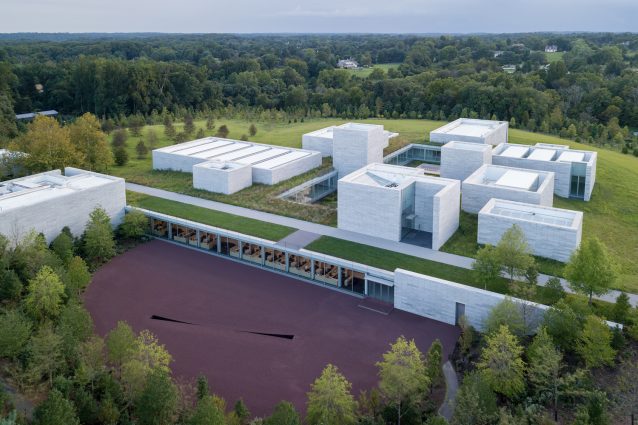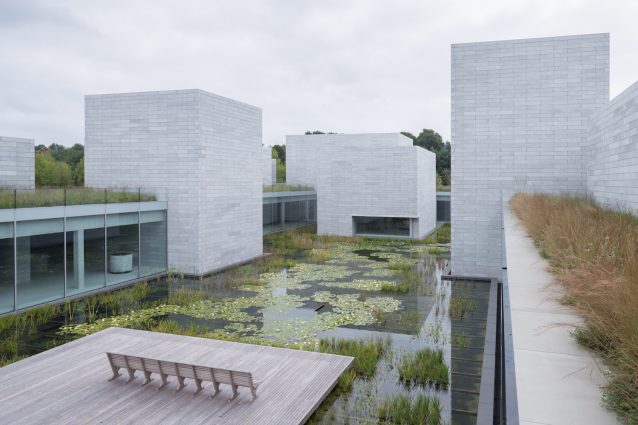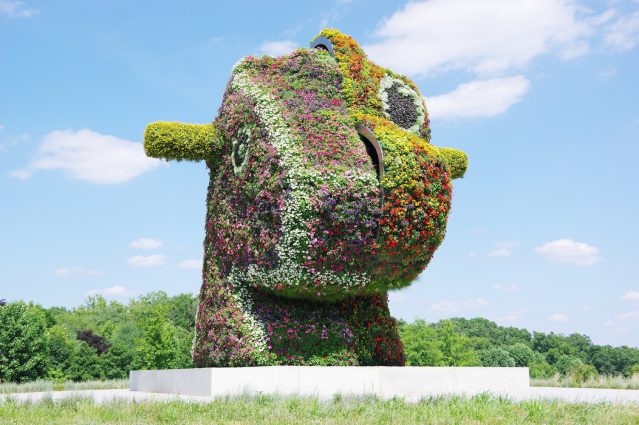It’s no accident that butterflies are the first to greet visitors to Glenstone’s new modern art mecca cradled in Potomac’s rolling countryside. Nature is among the most celebrated artists on the property and, at 230 acres, arguably dwarves the other massive — in size and reputation — works in Emily and Mitchell Rales’ prized private collection.
The Pavilions expansion, five years in the making, opens to the public on Thursday, Oct. 4 and comprises several new structures.
The Arrivals Hall, adjacent to the artful and unconventional parking grove, serves as a place to push “pause” on the outside world. Guides are on hand to greet guests, supply umbrellas if necessary and steer them down a path and over a footbridge. The walk takes about 10 minutes. Wildflowers wave visitors toward the main entrance.

Stoic and Strong
The 204,000-square-foot Pavilions is an architectural supernova, bright and bold but in no way outshining its contents. It sits within the landscape, not on it, and compliments Glenstone’s original 30,000-square-foot museum now known as the Gallery.
The Pavilions uses stacked concrete blocks, glass expanses and little else. The ceilings are concrete. There are no pillars. Nature supplies the light through skylights and clerestory windows. Inviting accents juxtapose austere building materials. A wood handrail on the main stairway holds your hand to the main level.
Here, the art journey beings: 11 rooms, 204,000 square feet. 65 works. 52 artists. Household names include Andy Warhol, Jasper Johns, Alberto Giacometti, Mark Rothko, Jean-Michel Basquiat, Robert Rauschenberg, Frank Stella, Jackson Pollack, Cy Twombly, Marcel Duchamp and dozens of other modern art masters. Most have rooms of their own. Museum Director Emily Rales explained, “Sublime paintings [like On Kawara’s ‘Moon Landing’] demand it. Landscape sculptures like ‘Collapse’ by Michael Heizer mandate it.”
The collection can be summed up as, “Seminal works of post-World War II art,” said Emily, with “a focus on challenging art.” “We [also] work as closely with the artist as possible to honor” his or her intentions, she added, citing more than 70 meetings with large-scale sculptor Robert Gober (“Partially Buried Sinks”) as an example.
At the center of the Pavilions blooms an 18,000-square-foot plant pool from which the exhibit rooms radiate.

A Detox to Daily Life
Emily Rales brands the Glenstone experience as “slow art.” “We hope visitors will slow [their] pulse and breathe and tune out the distractions of the outside world.” To that end, cell phones are discouraged, the number of daily visitors is limited, and installations are up for long periods of time, so visitors can return to experience the art in different light, different weather and with different companions.
There is also a sitting room that boasts the best view of the property and a help-yourself bookshelf stocked with an eclectic cast of literary artists we might find in the Rales’ own home — Rachel Carson, E.E. cummings, Anita Hill.
“We want Glenstone to be your museum,” said the Rales. The expansion includes two cafes and a bookstore, as if to say, “stay a little longer.”
“Slow art” prompts interactions with the Glenstone Guides, another hallmark of the museum. Stationed throughout the museum, uniformed in gray, this cadre of art lovers and learners — many from Glenstone’s own Emerging Professionals program — replace traditional text-laden wall didactics. They answer questions, experience a room with you and share behind-the-scenes knowledge about an artist or acquisition. One Guide in the Cy Twombly room remarked that the artist traveled with his pieces because he was that attached to them. A member of the acquisitions team in the Charles Ray room referred to Ray as “Charlie.” Moments like this invite a deeper relationship with the museum.

Field Trip
The Rales call the Pavilions a full-on collaboration with architect Thomas Phifer and landscape curator Adam Greenspan. The four visited 50-plus museums worldwide, noting particular successes to draw upon. The Louisiana in Denmark and The Menil in Houston made durable impressions on the team.
Phifer talked less about the building; more about the experience. “The first 10 minutes [from the car to the Pavilions] is critical…. It’s important to put time and space between the world and the art.” He seemed particularly proud of the plant pool, which “removes the horizon,” but said his biggest thrill is to see people fill the space. He considers the public the final element, but quickly circles back to what he considers the museum’s most central material: nature.
“The 100 sycamores are as much a part of the museum” as the works of art, said Greenspan. He, too, extols the check-your-cars-far-from-the-door philosophy baked into the blueprint, and the inter-related, holistic decisions behind the project.
Glenstone’s Pavilions is set to make its mark, locally and globally. It is significant and seamless. It is our “gift to the world” and a “legacy,” said the Rales, promising “free for all” admission in an effort to “expand audiences for art.”
If the sheer generosity of the project does not define it as a premier art destination, the diligence of its details do.
The Pavilions at Glenstone, 12100 Glen Road, Potomac, opens to the public on Oct. 4. Admission is free, but reservations are required. Visitors must be 12 or older and minors must be accompanied by an adult. For information, visit glenstone.org or call 301-983-5001.